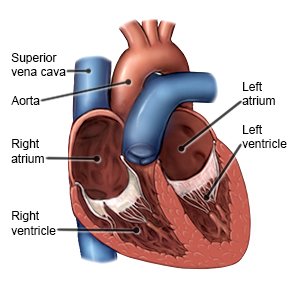Pericardial Effusion
Medically reviewed by Drugs.com. Last updated on Aug 4, 2025.
Pericardial effusion is a buildup of fluid in the pericardium. The pericardium is a 2-layer sac that surrounds the heart. The sac normally contains a small amount of clear fluid between its layers. This allows the heart to move smoothly against other organs in the chest as it beats. The fluid buildup puts pressure on your heart. This makes it difficult for your heart to pump. Fluid may collect slowly or quickly.
 |
WHILE YOU ARE HERE:
Informed consent
is a legal document that explains the tests, treatments, or procedures that you may need. Informed consent means you understand what will be done and can make decisions about what you want. You give your permission when you sign the consent form. You can have someone sign this form for you if you are not able to sign it. You have the right to understand your medical care in words you know. Before you sign the consent form, understand the risks and benefits of what will be done. Make sure all your questions are answered.
Medicines:
- Antibiotics help treat an infection caused by bacteria.
- NSAIDs help decrease swelling, pain, and fever.
- Steroids help decrease swelling.
Related medications
Tests:
- An EKG records your heart rhythm and how fast your heart beats. It is used to check for damage or problems in your heart.
- An echocardiogram is a type of ultrasound. Sound waves are used to show the structure and function of your heart.
- A CT or MRI scan takes pictures of your chest. The pictures may show fluid around your heart or other problems. You may be given contrast liquid to help your heart show up better in pictures. Tell the healthcare provider if you have ever had an allergic reaction to contrast liquid. Do not enter the MRI room with anything metal. Metal can cause serious injury. Tell the healthcare provider if you have any metal in or on your body.
- A sample of fluid from the pericardial sac may be taken with a needle. The fluid is sent to a lab for tests.
Treatment:
- Pericardial drainage relieves pressure on your heart so it can pump normally. A catheter is inserted into the pericardium to drain fluid.
- A balloon procedure is another way to drain extra fluid. A needle is put into the pericardium and a guidewire is threaded through the needle. The needle is then removed. A catheter (thin tube) with a balloon at its end is passed over the guidewire into the correct position in the pericardium. The balloon is inflated and deflated several times to create an opening for the fluid to drain out.
- Surgery may be done to remove part or most of the pericardium.
Treatment options
The following list of medications are related to or used in the treatment of this condition.
RISKS:
Left untreated, you may get scarring and stiffening of the pericardium that can affect the way your heart beats. This may cause decreased blood flow to your organs, which may become be life-threatening.
CARE AGREEMENT:
You have the right to help plan your care. Learn about your health condition and how it may be treated. Discuss treatment options with your healthcare providers to decide what care you want to receive. You always have the right to refuse treatment.© Copyright Merative 2025 Information is for End User's use only and may not be sold, redistributed or otherwise used for commercial purposes.
The above information is an educational aid only. It is not intended as medical advice for individual conditions or treatments. Talk to your doctor, nurse or pharmacist before following any medical regimen to see if it is safe and effective for you.
Learn more about Pericardial Effusion
Treatment options
Care guides
Symptoms and treatments
Further information
Always consult your healthcare provider to ensure the information displayed on this page applies to your personal circumstances.
